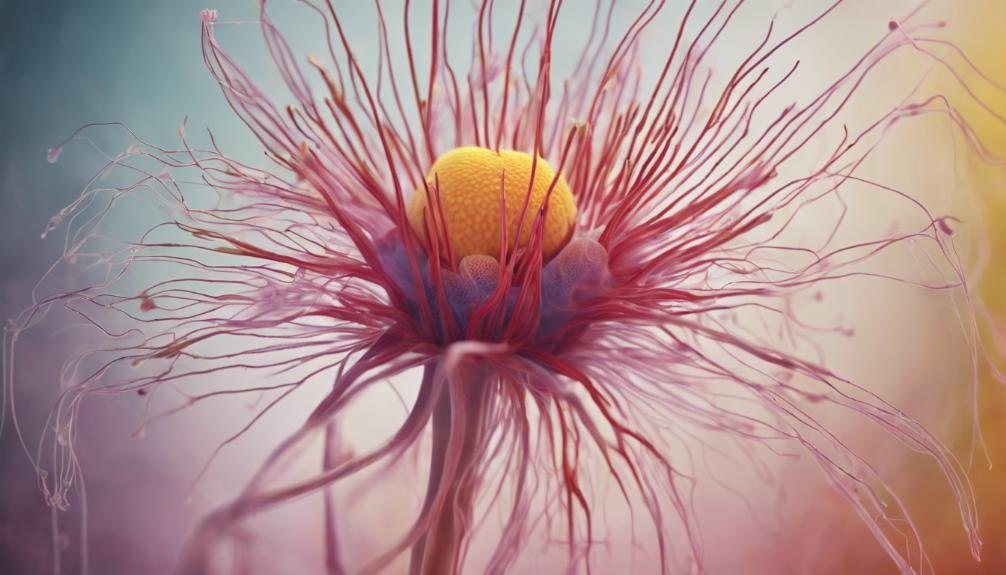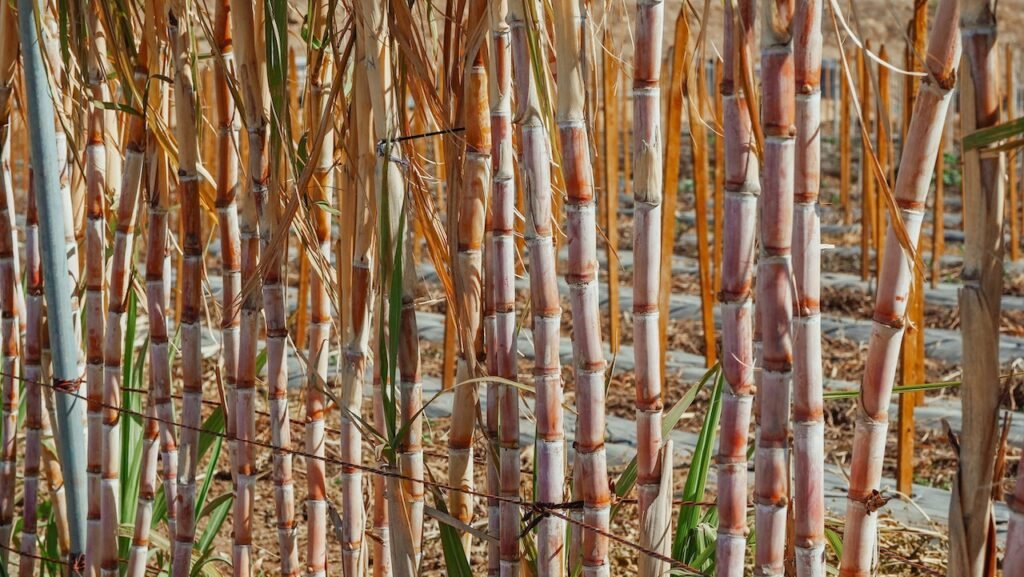You’re about to explore the intricate structures of male and female flowers. In male flowers, the stamen (comprising the anther and filament) produces pollen, which contains the male gametes. The anther produces pollen, while the filament supports it. In female flowers, the carpel (comprising the ovary, style, and stigma) receives pollen and facilitates fertilization. The ovary contains ovules where fertilization occurs, the style connects the ovary to the stigma, and the stigma receives pollen. As you examine these structures, you’ll discover how they work together to facilitate pollination and fertilization, and you’ll uncover the intricate details that bring new life to plants.
Key Takeaways
- The male reproductive organ in a flower, the stamen, consists of the anther and filament, producing and dispersing pollen for pollination.
- The female reproductive organ, the carpel, comprises the ovary, style, and stigma, which receives pollen and facilitates fertilization.
- The anther produces pollen, containing male gametes, while the filament supports the anther in the male flower structure.
- The ovary, style, and stigma in the female flower structure work together to receive pollen, guide pollen tubes, and facilitate fertilization.
- The coordinated effort of both male and female structures ensures successful reproduction of the plant through pollination and fertilization.
Male Flower Anatomy

When examining a flower, you’ll find that the male reproductive organs, comprising the stamen, are typically located in the outer whorl of the flower.
The stamen consists of two main parts: the anther and the filament. The anther produces pollen, which contains the male gametes, while the filament supports the anther.
You’ll notice that the stamen are often arranged in a specific pattern, exhibiting floral symmetry. This symmetry can be radial, bilateral, or asymmetrical, depending on the type of flower.
As you observe the flower’s male anatomy, you’ll also notice the petals, which are often colorful and play a vital role in attracting pollinators.
Petal coloration can vary greatly between species, ranging from vibrant hues to subtle pastels. The shape and size of the petals can also differ, depending on the type of flower.
The combination of petal coloration and shape can influence the flower’s overall appearance and functionality.
Female Flower Structure
You’ll find the female reproductive organs, comprising the carpel, typically situated in the center of the flower, surrounded by the stamen and petals.
During female development, the carpel undergoes a series of complex changes to form the ovary, style, and stigma.
The ovary is the lower part of the carpel, containing ovules where fertilization occurs.
The style is the narrow, elongated region connecting the ovary to the stigma, which is the pollen-receiving surface.
Floral initiation, the process by which flowers develop from buds, is critical in shaping the female flower structure.
As the flower grows, the carpel begins to differentiate into its various components.
The ovary wall thickens, and the ovules mature, preparing for fertilization.
The style and stigma also develop, ready to receive pollen from male flowers.
The precise arrangement of these female reproductive organs is vital for successful pollination and fertilization.
Reproductive Organs in Flowers

The reproductive organs in flowers, comprising both male and female structures, work in tandem to facilitate pollination and fertilization, ensuring the continuation of plant life.
As you explore into the intricacies of flower anatomy, you’ll discover that these reproductive organs have evolved over time to optimize their functions. In flower evolution, the development of reproductive organs has been influenced by plant hormones, which regulate growth and differentiation.
You’ll notice that the reproductive organs are typically located in the center of the flower. The female reproductive organ, comprising the stigma, style, and ovary, receives pollen grains from the male reproductive organ, consisting of the anther and filament.
When pollen germinates, a pollen tube forms, allowing sperm cells to travel through the style and into the ovary, where fertilization takes place. This complex process relies on the coordinated effort of both male and female structures, ensuring the successful reproduction of the plant.
The Role of Stamen
In the male reproductive organ, the stamen, comprising the anther and filament, plays a vital role in producing and dispersing pollen, which is then transported to the female reproductive organ, facilitating pollination.
As you examine the stamen, you’ll notice that it’s responsible for producing pollen grains, which contain the male gametes.
The anther, the pollen-producing part of the stamen, undergoes a process called microsporogenesis to form these grains.
During stamen development, the anther matures and releases pollen, allowing it to disperse and increase the chances of successful pollination.
Stamen evolution has led to diverse adaptations, such as changes in anther shape and size, to optimize pollen production and dispersal.
For instance, some plants have evolved to produce more pollen or have modified their anthers to better capture pollinators’ attention.
As you explore the intricate details of stamen development and evolution, you’ll appreciate the critical role it plays in the reproductive cycle of flowers.
Function of the Pistil

Pistils, the female reproductive organs of flowers, actively capture and process pollen, facilitating fertilization through a complex series of events.
As you dig deeper into the function of the pistil, you’ll discover it’s a highly specialized structure that’s vital for plant reproduction.
During pistil development, the stigma, style, and ovary differentiate, each with distinct roles in pollen reception, germination, and fertilization.
The stigma, often sticky or hairy, traps pollen grains, allowing them to germinate and form pollen tubes.
The style, a narrow channel, guides the pollen tube towards the ovary, where fertilization occurs.
Through pistil evolution, flowers have developed unique adaptations to guarantee successful pollination.
For instance, some plants have evolved to produce nectar, attracting pollinators that inadvertently transfer pollen.
Others have developed complex flower shapes, guaranteeing precise pollen placement.
As you explore the intricacies of pistil function, you’ll appreciate the remarkable complexity and diversity of plant reproductive strategies.
Flower Parts Working Together
As you examine the intricate relationships between a flower’s components, you’ll discover that the coordinated efforts of sepals, petals, stamens, and pistils orchestrate a delicate ballet, guaranteeing successful pollination and reproduction.
Each part plays a crucial role in this harmonious process, working together to achieve a common goal.
Pollen germination is the process where the stamens produce pollen, which germinates on the stigma, allowing pollen tubes to grow down through the style and into the ovary.
The petals attract pollinators, such as bees and butterflies, which transfer pollen between flowers, achieving floral harmony.
The sepals protect the delicate reproductive organs from damage and disease.
The pistils guide pollen tubes towards the ovules, guaranteeing fertilization occurs.
The fusion of male and female gametes results in seed production, completing the reproductive cycle.
Through this intricate dance, flowers guarantee their genetic material is passed on to the next generation, perpetuating the cycle of life.
As you explore further into the world of flowers, you’ll appreciate the remarkable complexity and beauty of their reproductive strategies.
Frequently Asked Questions
Can Flowers Change Sex From Male to Female or Vice Versa?
You’ll find that some plants exhibit sexual ambiguity, allowing them to change sex under certain conditions. Through floral manipulation, you can even induce sex changes in some species, but this isn’t a universal trait among all flowers.
Do All Plants Produce Both Male and Female Flowers?
You’ll find that not all plants produce both male and female flowers, as this strategy doesn’t offer evolutionary advantages for every species. This variation contributes to plant diversity, allowing adaptations to specific environments and reproductive strategies.
Are There Flowers With Both Male and Female Parts Combined?
You’re wondering if some flowers are like hermaphrodites, having both male and female parts combined. Yes, you’re right! Perfect flowers, also known as bisexual blooms, contain both stamens and pistils, allowing them to self-pollinate.
What Triggers the Release of Pollen in Male Flowers?
You’ll find that pollen release in male flowers is triggered when pollen maturity is reached, often coinciding with environmental cues like temperature, humidity, and light exposure, which signal the ideal time for pollination.
Can Flowers Self-Pollinate Without External Help?
You’ll find that many flowers can self-pollinate without external help, employing self-fertilization strategies like cleistogamy or autogamy, which don’t rely on pollen vectors like bees or wind, ensuring successful reproduction.


